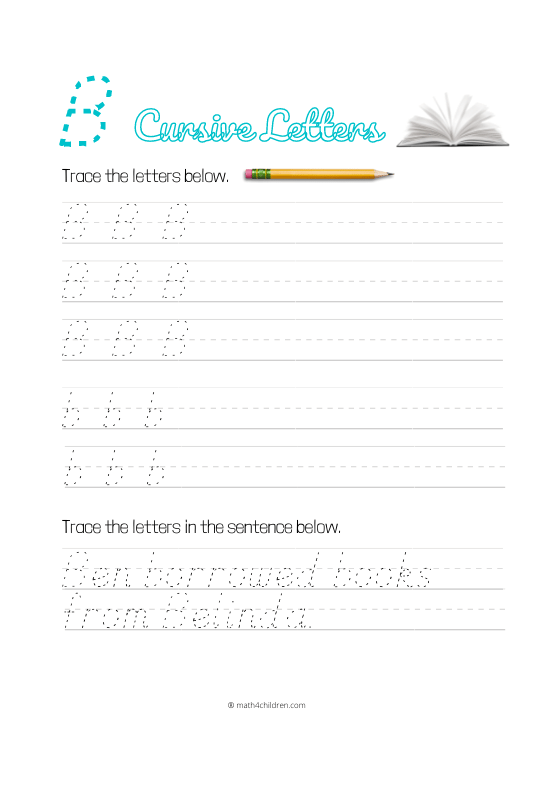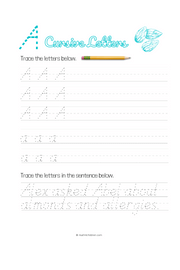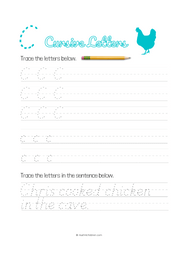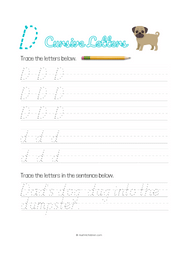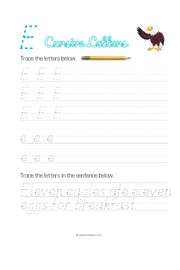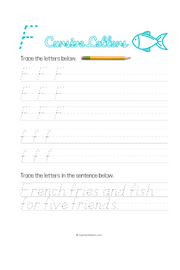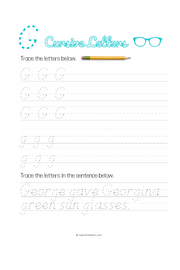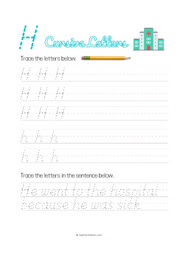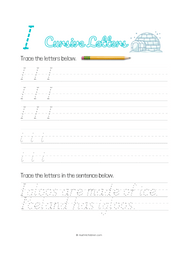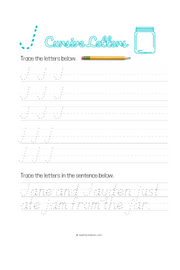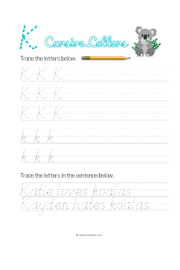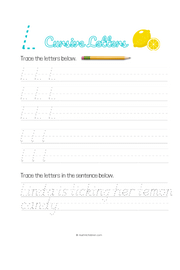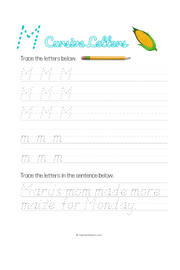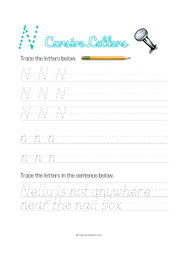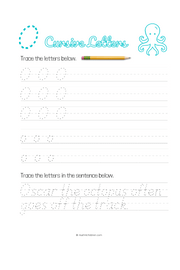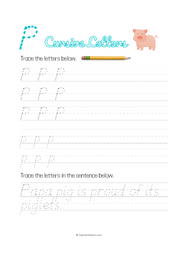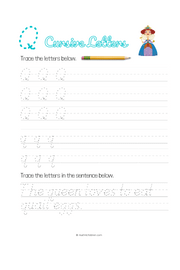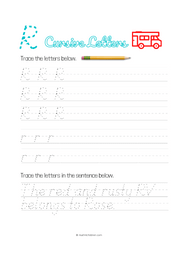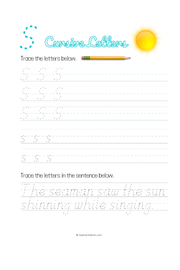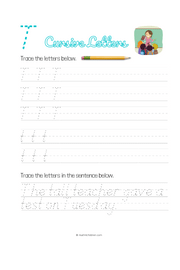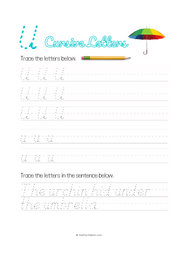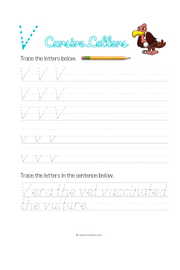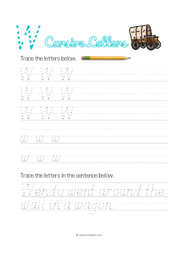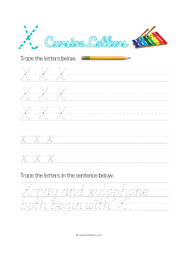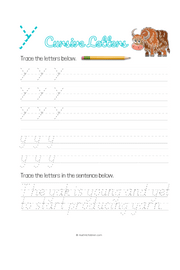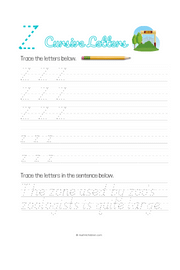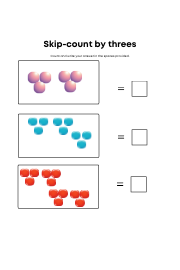Cursive B worksheet - Cursive capital and small letter B
Help your child practice writing the cursive letter B. There’s nothing like improving their ability in cursive through using printed worksheets – ones that will allow them to develop their fine motor skills in handling pencils, pens and other writing instruments to produce clear, legible and beautiful handwriting for any occasion.
Your child can get a solid handwriting workout with the best letter B cursive writing worksheets that we have to offer.
The letter B is big and bulky, requiring a complex range of fine hand motions to produce correctly in cursive form. It is perfectly normal for your child to end up creating overly large, chunky, or misshapen instances of this letter early in their cursive education.
At their age, children can truly benefit from parents and teachers who cultivate a love for both reading and writing. It is a big advantage in their handwriting progress if a child has developed a hobby for writing in their own journals, or writing things in general. This can indicate that they are making progress in nurturing both their creative ability and their skill in using writing implements.
There’s no one way in producing the best cursive letter “B” worksheets, but ours contain large, legible examples of the letter to serve as guides for your child to easily replicate “B” in its uppercase and lowercase instances. Our sheets also have practice rows – first for tracing letters, and then for your child to try and replicate the letters by themselves several times in a row.
Cursive B worksheet for kids
Cursive writing is a beautiful and practical way to write by hand, and learning to write in cursive can have numerous benefits for children and adults alike. Cursive B, in particular, is a fundamental letter in the cursive alphabet and is an important building block for learning how to write in cursive.
Learning to write in cursive can improve fine motor skills, increase brain activity, and even boost self-esteem and confidence. It can also be a relaxing and therapeutic way to express oneself, and it can be a useful tool for note-taking and writing letters.
On this page, we will provide a step-by-step guide on how to write the cursive B, as well as tips and tricks for mastering this letter and improving your overall cursive handwriting. We will also delve into the history of cursive writing and its evolution over time, and discuss the various benefits of learning to write in cursive.
To begin learning how to write the cursive B, it is important to first familiarize yourself with the basic stroke patterns of cursive writing. Cursive letters are formed by connecting several strokes together in a fluid, continuous motion, rather than writing each letter individually. The cursive B is formed by starting at the top of the letter, making a loop to the right, and then returning back to the starting point by making a downward stroke.
To practice writing the cursive B, start by writing the letter on a blank sheet of paper, using a pencil or pen with a medium to thick tip. Make sure to hold your writing instrument correctly and use proper posture while writing. It may also be helpful to use a lined sheet of paper or a handwriting practice worksheet to guide your penmanship.
As you begin to write the cursive B, start at the top of the letter and make a loop to the right. This loop should be about the same size as the other letters in your cursive writing. From there, bring your pen back down to the starting point and make a downward stroke. This stroke should be slightly slanted to the right and should end in a small curve.
Once you have mastered the basic stroke pattern for the cursive B, you can practice writing the letter in words and sentences. Some helpful words to practice with include: boy, ball, bat, bed, and big. As you become more comfortable with the cursive B, try writing it in longer words and sentences to improve your handwriting fluency and speed.
In addition to practicing the cursive B on its own, it is also important to practice connecting the letter to other letters in the cursive alphabet. Cursive writing is all about connecting letters together, and being able to smoothly transition from one letter to the next is an essential skill. To practice connecting the cursive B to other letters, try writing words and sentences that contain the letter B, such as:
- book
backpack
baby
bus
As you practice writing the cursive B and connecting it to other letters, pay attention to your handwriting technique and try to maintain a consistent, fluid motion. It may also be helpful to use a handwriting guide or reference sheet to help you form the letter correctly.
In conclusion, learning to write cursive B is an important step in mastering cursive handwriting. With practice and patience, you can improve your handwriting fluency and legibility and enjoy all of the benefits that come with learning this timeless skill. Whether you are a student learning cursive for the first time, or an adult looking to improve your handwriting, cursive B is a great letter to start with. We hope that our guide has provided all the information you were in search of.
Mastering the Art of Writing the B in Cursive
Writing in cursive is a beautiful way to express your thoughts and ideas on paper. It adds a touch of elegance to your handwriting and is often associated with tradition and sophistication. However, mastering the art of writing in cursive can be challenging, especially if you're just starting. In this article, we'll focus on one specific letter - the B in cursive. We'll explore its unique shape, common mistakes to avoid, and tips and tricks to help you write the perfect B in cursive.
The Anatomy of the B in Cursive
The B in cursive is a letter with a unique shape, and it's crucial to understand its anatomy to write it correctly. Here's a breakdown of the B in cursive:
- The B starts with a loop that forms a complete circle on the top.
- The loop transitions into a downward stroke, creating the spine of the letter.
- The spine curves and transitions into a loop at the bottom, which closes the letter.
Heading 2: Common Mistakes When Writing the B in Cursive
When learning to write the B in cursive, there are some common mistakes that beginners make. Here are a few examples:
-
Incomplete top loop: Many people make the mistake of not closing the loop at the top of the letter, leaving it open-ended.
-
Incorrect spine angle: The spine of the B should slant at a 45-degree angle. Beginners often make the mistake of making the angle too steep or too shallow.
-
Overlapping bottom loop: The bottom loop of the B should not overlap the spine. Beginners often make the mistake of merging the loop and the spine together, resulting in a messy-looking letter.
Tips and Tricks for Writing the B in Cursive
Here are some tips and tricks that can help you write the B in cursive more easily and confidently:
-
Practice the letter in isolation: Start by practicing the letter B in isolation before integrating it into words or sentences. This will help you focus on the letter's shape and form.
-
Slow down and focus on each stroke: Writing in cursive requires a slow and deliberate approach. Take your time to focus on each stroke and transition to form the letter.
-
Use lined paper or a guide sheet: Lined paper or guide sheets can help you maintain consistency in size and spacing.
Practice Exercises for Writing the B in Cursive
Here are some practice exercises that can help you improve your B in cursive:
-
Trace the letter: Use a worksheet or a piece of paper with a B in cursive on it and trace over it. This will help you get a feel for the letter's shape.
-
Write the letter repeatedly: Write the letter B in cursive repeatedly until you feel comfortable with its shape and form.
-
Write words that contain the letter B: Practice writing words that contain the letter B in cursive, such as "butterfly" or "basketball." This will help you integrate the letter into words and sentences.
FAQs:
Q: Is it essential to learn cursive handwriting in today's digital age? A: While cursive handwriting is not as essential as it was in the past, it is still a valuable skill to have. Writing in cursive can help improve fine motor skills and is often required in certain academic and professional settings.
Q: How long does it take to learn to write the B in cursive? A: Learning to write in cursive can take time and practice, and the length of time it takes to learn will depend on the individual. Some people may learn quickly, while others may take more time. The key is to be patient, practice regularly, and seek feedback to improve.
Q: Can I use different styles of cursive for the letter B? A: While there are different styles of cursive, it's essential to choose a style and stick with it. Consistency is essential in cursive writing, as it helps with legibility and readability.
Conclusion:
Learning to write the B in cursive can be a challenging but rewarding experience. With practice and dedication, you can master this elegant letter and add a touch of sophistication to your handwriting. Remember to focus on the letter's anatomy, avoid common mistakes, and practice regularly. By following the tips and tricks outlined in this article, you'll be well on your way to writing the perfect B in cursive.

